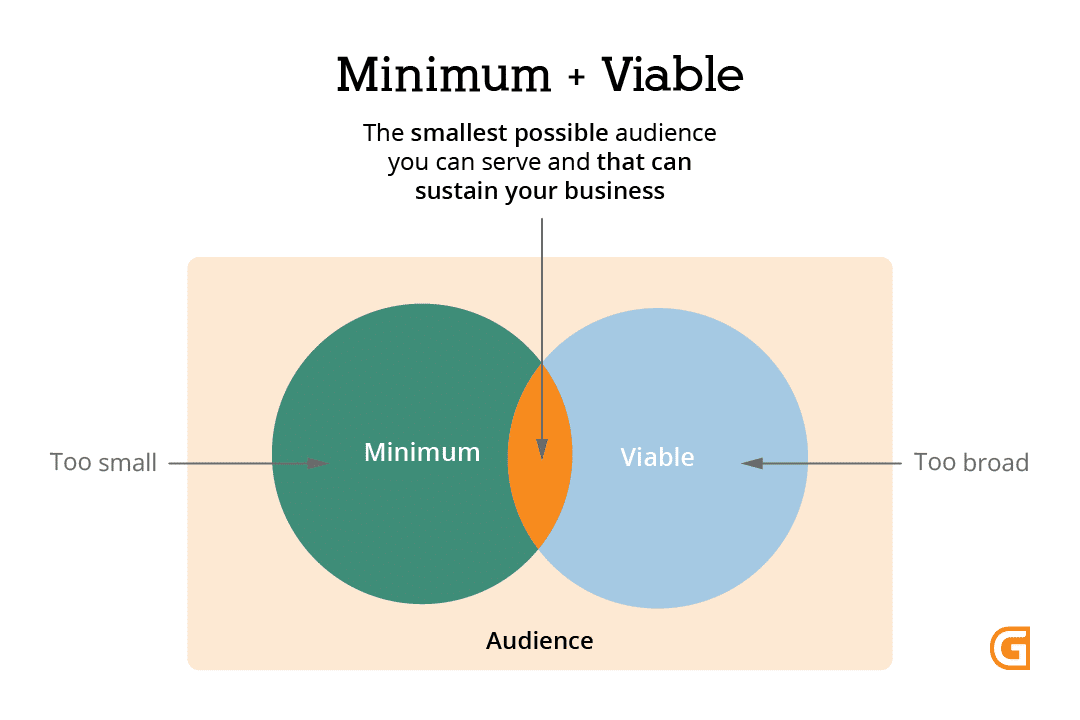
From Minimum Viable Product to Minimum Viable Audience
Developing new services is a process that many companies get stuck in. There are so many factors involved in producing the perfect product or the best service that companies face several pitfalls.
The switch from Minimum Viable Product to Minimum Viable Audience is such a pitfall. While it makes sense to start with your audience, many product developers end up with a focus on the product rather than their audience.
Problems in the development of new services
- When a sample of 1 good customer shows that there is a demand for a certain service or product, the assumption is too quickly made that there is a large market demand for it.
- People think inside out, focusing on the product. Which features can we develop? How can we evolve our service?
- There is no connection with potential consumers. This is called product-push or product-first
This is not purely a negative thing, sure quite some beautiful products have been developed in this way. But there are risks involved: a wrong image of what customers need, difficulty in launching the product, incorrect focus, too much effort to get to the market, your sales are disappointing…
The difference between Minimum Viable Product and Minimum Viable Audience
Do not step into the “product-trap”
- Assume a value proposition that is clearly in line with the pain (pains) and possible profit (gains) of your potential customers.
- Introduce a form of customer interaction as early as possible in the process so that feedback and input can be included immediately.
Ways to launch a product
There are several ways to launch a product:
Traditional
- Start a product roadmap
- Work slowly towards an ideal end product in phases
- Customers are involved in testing, feedback on features
-
For example, this form is good for establishing solid IT infrastructure platforms. After all, it is clear in advance what the specifications are and, above all, a well-documented, robust design is required, which is approved phase by phase.
Minimum Viable Product
- Working in slices towards optimal experiences
- Customers are involved in partial deliveries of the MVPs
- Basis for the ‘beta’ thinking: delivering products with minimal features to get feedback on and to iteratively improve
Minimum Viable Product thinking is good for services such as large next level services such as Google Maps, etc. There is a clear vision of what the product should be, but there is still a lot of value to be gained from involving customers in feedback on early versions.
Minimum Viable Audience
- From the start of the idea already designing the product in collaboration with the customer
- Customers are involved in the value proposition
Minimum Viable Audience thinking is the ultimate form of co-creating new products. It lends itself well for niche services, for which you have a specific target group. For those customers you want to make something that they will use and will support.
Let’s dive into ‘Minimum Viable’ a little bit more
Both the concept of Minimum Viable Product and Minimum Viable Audience are based on the idea of “minimum viable”. Minimum + viable is the smallest possible unit that you need to prove or create something bigger.
For a Minimum Viable Product, this is the smallest set of features that you design in the product so that you can experience the product as a whole. For Minimum Viable Audience, this is the smallest possible target group that you can serve, so that you can bring your business idea to the market.
The smallest possible target group varies. When developing a new innovative form of transport, your minimum is a lot bigger than when developing a new blog with paid content. Although the minimum varies, serving the smallest possible target group remains the rationale behind Minimum Viable Audience.

Aangepast naar een model van Guerric.
Connect with your target audience for success
Many companies are enthusiastic about the products or services they offer, but if they go to the customer, it often becomes a completely different story. Customers look at the product from a completely different context. Still the product may be so well thought out, if your target group cannot connect with it, it won’t work.
How can you connect yourself with that target group? A story or common pain or vision is a nice first step. To enter the process together, you need something that you share, something with which you can connect that group to you. That is an important element if you choose the Minimum Viable Audience approach.
How to start with the Minimum Viable Audience?
- Based on the essence of the value proposition, determine what kind of audience fits.
- Describe this audience as a niche group: what are the characteristics and context they live and work in? What problems do they have?
- Make it practical: how can you get in touch with this group?
- Content: Tell stories about your idea, your why and your vision towards your target group.
- Contact: Find 1-on-1 contact with representatives of that target group. Find them, discuss your ideas, ask for feedback and sharpen your idea based on that.
- Community: Facilitate organized group interaction around the core idea of your proposition. Meet-ups, meetings, round-the-table sessions, knowledge lunches… bring like-minded people from that target group together. Here you can get feedback that you can use to improve your product.
- Co-creation: Let your target group also think along explicitly about the product and give them the opportunity to help shape it. Your target audience can be part of the creation process.

By organizing co-creation you also allow your target group to think explicitly about the product and give them the opportunity to help shape it.
Asking the right questions
For Minimum Viable Audience it is important to ask the right questions, to hit the right chord. A good tip is to look for stories from the recent past, not the perception of the actual situation. That sounds rather cryptic, so here’s an example: To a perception-fact question like “Do you ever exercise?” you get a short perception-fact answer. “Yes of course. 2 times a week.”
But if you start asking the question differently – “Did you work out last week? – you get a more detailed answer with much more context: “No last week, I don’t exercise as often as I would like, I actually often can’t find the time to it.” The answer about what they want to do then changes to the answer about what they really do.
So asking the right questions is very important. Be specific, ask about the past and reflect on your audience.
I am curious about your experiences
Minimum Viable Audience thinking is still in its infancy. My experience shows that thinking in particular helps a lot in realizing innovative product ideas. Involving the customer is often something that has a large barrier in advance, but afterwards leads to many good insights. Examples are very welcome, so if you recognize elements of this from your experience, let me know!
 Mark Geljon
Mark Geljon 

